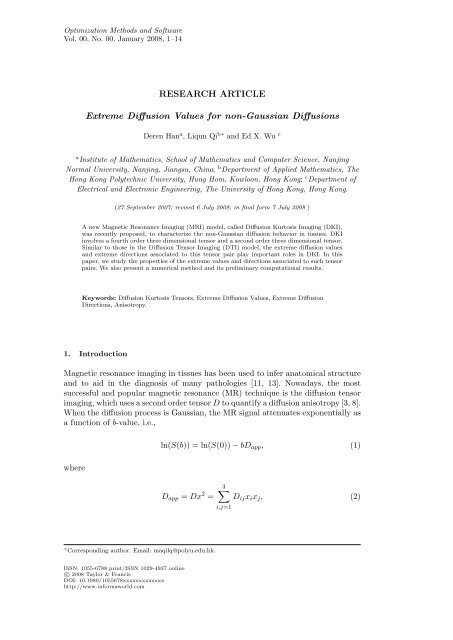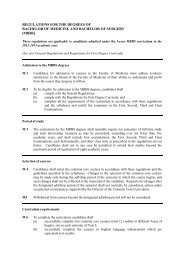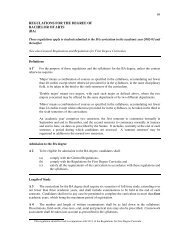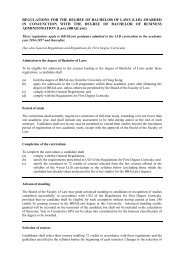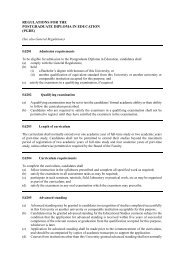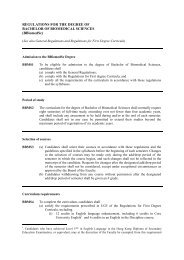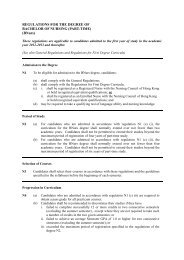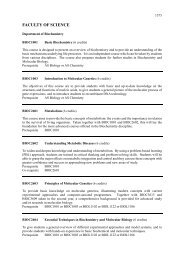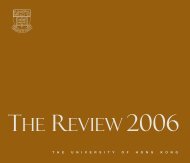RESEARCH ARTICLE Extreme Diffusion Values for non-Gaussian ...
RESEARCH ARTICLE Extreme Diffusion Values for non-Gaussian ...
RESEARCH ARTICLE Extreme Diffusion Values for non-Gaussian ...
You also want an ePaper? Increase the reach of your titles
YUMPU automatically turns print PDFs into web optimized ePapers that Google loves.
Optimization Methods and Software<br />
Vol. 00, No. 00, January 2008, 1–14<br />
<strong>RESEARCH</strong> <strong>ARTICLE</strong><br />
<strong>Extreme</strong> <strong>Diffusion</strong> <strong>Values</strong> <strong>for</strong> <strong>non</strong>-<strong>Gaussian</strong> <strong>Diffusion</strong>s<br />
Deren Han a , Liqun Qi b∗ and Ed X. Wu c<br />
a Institute of Mathematics, School of Mathematics and Computer Science, Nanjing<br />
Normal University, Nanjing, Jiangsu, China; b Department of Applied Mathematics, The<br />
Hong Kong Polytechnic University, Hung Hom, Kowloon, Hong Kong; c Department of<br />
Electrical and Electronic Engineering, The University of Hong Kong, Hong Kong.<br />
(27 September 2007; revised 6 July 2008; in final <strong>for</strong>m 7 July 2008 )<br />
A new Magnetic Resonance Imaging (MRI) model, called <strong>Diffusion</strong> Kurtosis Imaging (DKI),<br />
was recently proposed, to characterize the <strong>non</strong>-<strong>Gaussian</strong> diffusion behavior in tissues. DKI<br />
involves a fourth order three dimensional tensor and a second order three dimensional tensor.<br />
Similar to those in the <strong>Diffusion</strong> Tensor Imaging (DTI) model, the extreme diffusion values<br />
and extreme directions associated to this tensor pair play important roles in DKI. In this<br />
paper, we study the properties of the extreme values and directions associated to such tensor<br />
pairs. We also present a numerical method and its preliminary computational results.<br />
Keywords: <strong>Diffusion</strong> Kurtosis Tensors, <strong>Extreme</strong> <strong>Diffusion</strong> <strong>Values</strong>, <strong>Extreme</strong> <strong>Diffusion</strong><br />
Directions, Anisotropy.<br />
1. Introduction<br />
Magnetic resonance imaging in tissues has been used to infer anatomical structure<br />
and to aid in the diagnosis of many pathologies [11, 13]. Nowadays, the most<br />
successful and popular magnetic resonance (MR) technique is the diffusion tensor<br />
imaging, which uses a second order tensor D to quantify a diffusion anisotropy [3, 8].<br />
When the diffusion process is <strong>Gaussian</strong>, the MR signal attenuates exponentially as<br />
a function of b-value, i.e.,<br />
where<br />
ln(S(b)) = ln(S(0)) − bD app , (1)<br />
D app = Dx 2 =<br />
3∑<br />
D ij x i x j , (2)<br />
i,j=1<br />
∗ Corresponding author. Email: maqilq@polyu.edu.hk.<br />
ISSN: 1055-6788 print/ISSN 1029-4937 online<br />
c○ 2008 Taylor & Francis<br />
DOI: 10.1080/1055678xxxxxxxxxxxxx<br />
http://www.in<strong>for</strong>maworld.com
2 Deren Han, Liqun Qi and Ed X. Wu<br />
is the apparent diffusion coefficient (ADC) along the gradient direction x =<br />
(x 1 , x 2 , x 3 ) with components x i , i = 1, 2, 3 and ∑ 3<br />
i=1 x2 i = 1,<br />
(<br />
b = (γδg) 2 ∆ − δ )<br />
3<br />
and g is the gradient strength, γ is the proton gyromagnetic ratio, δ is a pulse duration,<br />
∆ is a time interval between the centers of the diffusion sensitizing gradient<br />
pulse, and D is a symmetric second order tensor with elements D ij , i, j = 1, 2, 3.<br />
The success of DTI is based on the assumption that water molecules obey <strong>Gaussian</strong><br />
diffusion in biological tissues. In reality, we often meet diffusions that are<br />
<strong>non</strong>-<strong>Gaussian</strong> in the confining environment of biological tissues, causing that the<br />
DTI model breaks down [1, 3]. For example, when DTI is used in regions where<br />
the fibers cross or merge, difficulty is often encountered since with current MR<br />
resolution, voxel averaging of different fiber tracts is frequent and unavoidable.<br />
To overcome this problem, new MR imaging models [2, 9, 14] have been proposed,<br />
which use higher order tensors, rather than just a second order tensor used in DTI,<br />
to characterize the process of diffusion. One of such new MR imaging models is<br />
diffusion kurtosis imaging [6, 10]. In that model, a fourth order three dimensional<br />
fully symmetric tensor, called the diffusion kurtosis (DK) tensor, is proposed to<br />
describe the <strong>non</strong>-<strong>Gaussian</strong> behavior of water molecules in tissues. That is, it is<br />
assumed that the MR signal attenuates as a function of b-value in the following<br />
way,<br />
ln(S(b)) = ln(S(0)) − bD app + 1 6 b2 D 2 appK app , (3)<br />
where K app is the apparent kurtosis coefficient (AKC) along x,<br />
K app = M D<br />
2<br />
Dapp<br />
2 W x 4 , (4)<br />
and<br />
3∑<br />
W x 4 ≡ W ijkl x i x j x k x l ,<br />
i,j,k,l=1<br />
M D = D 11 + D 22 + D 33<br />
3<br />
is the mean diffusivity.<br />
For the DTI model, Pierpaoli and Basser [15] pointed out “The most intuitive and<br />
simplest rotationally invariant indices are ratios of the principal diffusivities, such<br />
as the dimensionless anisotropy ratio λ 1 /λ 3 that measures the relative magnitudes<br />
of the diffusivities along the fiber-tract direction and one transverse direction.” In<br />
DKI, the D-eigenvalues of W and the D-eigenvector associated with these eigenvalues<br />
also play important roles. They describe the extreme AKC values and the<br />
extreme deviations of the diffusion from <strong>Gaussian</strong> diffusion, and are invariant under<br />
rotations of the co-ordinate systems [19, 21]. However, some important properties<br />
in the DKI model need to be studied further. For example, which direction is the<br />
fastest/slowest diffusion direction in the DKI model How can we measure the
<strong>Extreme</strong> diffusion values <strong>for</strong> <strong>non</strong>-<strong>Gaussian</strong> diffusions 3<br />
anisotropy of the tissue To answer these questions, we have to find the extreme<br />
points associated to the diffusion tensor D and the diffusion kurtosis tensor W<br />
together. In this paper, we study these problems and propose a numerical method<br />
to find such extreme points. We also present some numerical examples to illustrate<br />
the method.<br />
2. Notation and Preliminary Results<br />
We use the notation in [4, 12, 16–19] <strong>for</strong> the tensors and vectors. We use x =<br />
(x 1 , x 2 , x 3 ) T to denote the direction vector, which is denoted as n = (n 1 , n 2 , n 3 ) T<br />
in [6, 10]. According the result of [6], the ADC and AKC <strong>for</strong> a single direction<br />
should satisfy the relationship (3), i.e.,<br />
ln[S(b)] = ln[S(0)] − bD app + 1 6 b2 D 2 appK app . (5)<br />
D is a second order tensor and W is a fourth order tensor, whose elements are<br />
obtained by filling experimental data into equation (5) and solving the resulting<br />
system of linear equations by singular value decomposition or least squares methods.<br />
Let the eigenvalues of D be α 1 ≥ α 2 ≥ α 3 . Then the mean diffusivity [3] can<br />
be calculated by<br />
M D = α 1 + α 2 + α 3<br />
.<br />
3<br />
In the DTI model, one assumes that the diffusion obeys a <strong>Gaussian</strong> distribution<br />
and there is no quadratic term in (5), i.e., the ADC <strong>for</strong> a single direction should<br />
satisfy the relationship (1)<br />
ln[S(b)] = ln[S(0)] − bD app . (6)<br />
In this case, the directions of the fastest and the slowest diffusion are eigenvectors<br />
associated to the largest and the smallest eigenvalues of the second order tensor<br />
D, which can be obtained via solving the optimization problems<br />
max Dx 2<br />
s.t. x T x = 1,<br />
(7)<br />
and<br />
min Dx 2<br />
s.t. x T x = 1,<br />
(8)<br />
respectively. For the DKI model, the study in [19] was focused on the properties<br />
of W which can be used to measure the deviation of the diffusion from a <strong>Gaussian</strong><br />
one. For example, the AKC value is used to measure the average deviation; the<br />
largest and smallest D-eigenvalues of the fourth order tensor W , defined as<br />
max W x 4<br />
s.t. Dx 2 = 1,<br />
(9)
4 Deren Han, Liqun Qi and Ed X. Wu<br />
and<br />
min W x 4<br />
s.t. Dx 2 = 1,<br />
(10)<br />
can be used to measure the largest and the smallest deviation from <strong>Gaussian</strong> diffusion<br />
and the associated eigenvectors are the fastest and the slowest deviation<br />
directions.<br />
In a similar way as in the DTI model, we are now going to find the fastest and the<br />
slowest diffusion values and the associated diffusion directions of water molecules<br />
in the tissue, under a <strong>non</strong>-<strong>Gaussian</strong> diffusion that has relationship (5). That is, we<br />
need to solve the following optimization problems<br />
max Dx 2 − 1 6 bM 2 D W x4<br />
s.t. x T x = 1,<br />
(11)<br />
and<br />
min Dx 2 − 1 6 bM 2 D W x4<br />
s.t. x T x = 1.<br />
(12)<br />
The solutions of (11) and (12) depend on the second order tensor D and the fourth<br />
order tensor W . Thus, our tasks are to find some useful properties of solutions<br />
of (11) and (12), the extreme values and the associated extreme directions of a<br />
tensor pair (D, W ), and to design numerical methods <strong>for</strong> finding such values and<br />
directions.<br />
It is known that Dx is a vector in R 3 with its ith component as<br />
(Dx) i =<br />
3∑<br />
D ij x j ,<br />
j=1<br />
<strong>for</strong> i = 1, 2, 3. As in [16–19], we denote W x 3 as a vector in R 3 with its ith component<br />
as<br />
(W x 3 ) i =<br />
3∑<br />
j,k,l=1<br />
W ijkl x j x k x l ,<br />
<strong>for</strong> i = 1, 2, 3. Without loss of generality, we assume that D is positive definite.<br />
Then α 1 ≥ α 2 ≥ α 3 > 0. In practice, this assumption is natural, as the ADC value<br />
should be positive in general.<br />
3. Properties of the <strong>Extreme</strong> <strong>Values</strong><br />
The critical points of problems (11) and (12) satisfy the following equation <strong>for</strong><br />
some λ ∈ R:<br />
{<br />
Dx −<br />
1<br />
3 bM 2 D W x3 = λx,<br />
x T x = 1.<br />
(13)
<strong>Extreme</strong> diffusion values <strong>for</strong> <strong>non</strong>-<strong>Gaussian</strong> diffusions 5<br />
Let ¯W = 1 3 bM D 2 W . Then (13) can be rewritten as<br />
{ Dx − ¯W x 3 = λx,<br />
x T x = 1.<br />
(14)<br />
A real number λ satisfying (13) with a real vector x is called an extreme diffusion<br />
value of the <strong>non</strong>-<strong>Gaussian</strong> diffusion, and the real vector x associated to λ is called<br />
an extreme diffusion direction.<br />
The following theorem shows the existence of the extreme diffusion values.<br />
Theorem 3.1 The extreme diffusion values always exist. If x is a solution of (14)<br />
associated with an extreme diffusion value λ, then<br />
λ = Dx 2 − ¯W x 4 . (15)<br />
The largest diffusion value is equal to λ max , and the smallest diffusion value is<br />
equal to λ min .<br />
Proof. The feasible regions of (11) and (12) are compact and their objective<br />
functions are continuous. Hence, each of these two optimization problems has at<br />
least one solution, which must satisfy (14) with corresponding Lagrangian multipliers.<br />
Hence, the largest diffusion value and the smallest diffusion value always<br />
exist and (15) follows from the fact (14) directly. This completes the proof. □<br />
The following theorem shows an important property of the extreme diffusion<br />
values.<br />
Theorem 3.2 The extreme diffusion values of a <strong>non</strong>-<strong>Gaussian</strong> diffusion are invariant<br />
under rotations of coordinate systems.<br />
Proof. With a rotation, x, D and ¯W are converted to y = P x, ˆD = DP 2 , and<br />
Ŵ = ¯W P 4 , respectively. Here, P = (p ij ) is the rotation matrix and the elements<br />
of ˆD and Ŵ are defined by 3∑<br />
ˆDij = D i ′ j ′ p i ′ i p j ′ j ,<br />
and<br />
i ′ ,j ′ =1<br />
Ŵ ijkl =<br />
3∑<br />
i ′ ,j ′ ,k ′ ,l ′ =1<br />
¯W i ′ j ′ k ′ l ′ p i ′ i p j ′ j p k ′ k p l ′ l ,<br />
see [16] <strong>for</strong> the definition of orthogonal similarity. If λ is an extreme diffusion value<br />
with an extreme direction x, then we have<br />
{ ˆDy − Ŵ y 3 = λy,<br />
y T y = 1,<br />
indicating that λ is still an extreme diffusion value in the new coordinate system.<br />
Thus, extreme diffusion values of <strong>non</strong>-<strong>Gaussian</strong> diffusion are invariant under<br />
rotations of coordinate systems.<br />
□
6 Deren Han, Liqun Qi and Ed X. Wu<br />
4. A Method <strong>for</strong> Finding the <strong>Extreme</strong> Points<br />
To find the extreme diffusion values in DKI, we need to solve optimization problems<br />
(11) and (12), which are optimization problems with polynomial objective functions<br />
and constraints. The first-order optimal conditions <strong>for</strong> (11) and (12) are system of<br />
polynomial equations (13). For solving this system of polynomial equations, we<br />
can use Groebner bases and resultants in elimination theory, see [5, 20]. However,<br />
using such methods directly to (13) may be time consuming. Moreover, the final<br />
one variable equation derived from (13) may have higher degree, which makes it<br />
sensitive to the coefficients.<br />
In the following, we propose a direct method to solve (13), which fully uses the<br />
structure of the problem. The first step is to eliminate λ from the system and then<br />
uses the last equation to eliminate x 3 from the system. Finally, it solves a system<br />
of polynomial equations with two variables, adopting the method of resultants.<br />
Note that Theorem 3.2 indicates that we may rotate the co-ordinate system<br />
such that the three orthogonal eigenvectors of D are used as the co-ordinate base<br />
vectors. In that co-ordinate system, the representative matrix of D is a diagonal<br />
matrix. There<strong>for</strong>e, we may assume that<br />
D =<br />
⎛<br />
⎝ α ⎞<br />
1 0 0<br />
0 α 2 0 ⎠ ,<br />
0 0 α 3<br />
which implies that Ŵ = ¯W . Consequently, (14) can be written as<br />
Ŵ 1111 x 3 1 + 3Ŵ1112x 2 1 x 2 + 3Ŵ1113x 2 1 x 3 + 3Ŵ1122x 1 x 2 2 + 6Ŵ1123x 1 x 2 x 3<br />
+3Ŵ1133x 1 x 2 3 + Ŵ1222x 3 2 + 3Ŵ1223x 2 2 x 3 + 3Ŵ1233x 2 x 2 3 + Ŵ1333x 3 3 = (α 1 − λ)x 1 ,<br />
Ŵ 2111 x 3 1 + 3Ŵ1122x 2 1 x 2 + 3Ŵ1123x 2 1 x 3 + 3Ŵ1222x 1 x 2 2 + 6Ŵ1223x 1 x 2 x 3<br />
+3Ŵ1233x 1 x 2 3 + Ŵ2222x 3 2 + 3Ŵ2223x 2 2 x 3 + 3Ŵ2233x 2 x 2 3 + Ŵ2333x 3 3 = (α 2 − λ)x 2 ,<br />
Ŵ 1113 x 3 1 + 3Ŵ1123x 2 1 x 2 + 3Ŵ1133x 2 1 x 3 + 3Ŵ1223x 1 x 2 2 + 6Ŵ1233x 1 x 2 x 3<br />
+3Ŵ1333x 1 x 2 3 + Ŵ2223x 3 2 + 3Ŵ2233x 2 2 x 3 + 3Ŵ2333x 2 x 2 3 + Ŵ3333x 3 3 = (α 3 − λ)x 3 ,<br />
x 2 1 + x2 2 + x2 3 = 1. (16)<br />
Note that the coefficients in the above equations come from the fact that the<br />
tensor Ŵ is symmetric, i.e., its entries Ŵijkl are invariant under any permutation<br />
of their indices i, j, k and l.<br />
To find the extreme diffusion values and the associated extreme diffusion directions,<br />
we have to solve the above system of polynomial equations on x 1 , x 2 , x 3 and<br />
λ. For this system of equations, we have the following result.<br />
Theorem 4.1 We have the following results on the extreme diffusion values and<br />
their associated extreme diffusion directions.<br />
(a). If Ŵ 1112 = Ŵ1113 = 0, then λ = α 1 − Ŵ1111 is an extreme diffusion values of the<br />
<strong>non</strong>-<strong>Gaussian</strong> diffusion with the extreme diffusion direction x = (1, 0, 0) ⊤ .<br />
(b). For any real roots t of the following equations:<br />
⎧<br />
⎨ Ŵ 1112 t 4 − (Ŵ1111 − 3Ŵ1122 − α 1 + α 2 )t 3 − 3(Ŵ1112 − Ŵ1222)t 2<br />
−(3Ŵ1122 −<br />
⎩<br />
Ŵ2222 − α 1 + α 2 )t − Ŵ1222 = 0,<br />
Ŵ 1113 t 3 + 3Ŵ1123t 2 + 3Ŵ1223t + Ŵ2223 = 0,<br />
(17)
<strong>Extreme</strong> diffusion values <strong>for</strong> <strong>non</strong>-<strong>Gaussian</strong> diffusions 7<br />
λ = Dx 2 − Ŵ x4<br />
is an extreme diffusion values with the corresponding extreme diffusion direction<br />
x = ± 1 √<br />
1 + t 2 (t, 1, 0)⊤ . (18)<br />
(c). λ = Dx 2 − Ŵ x4 and<br />
1<br />
x = ± √<br />
u 2 + v 2 + 1 (u, v, 1)⊤ (19)<br />
constitute an extreme diffusion values and extreme diffusion direction pair, where<br />
u and v are real solutions of the following system of polynomial equations<br />
⎧<br />
Ŵ 1113 u 4 + 3Ŵ1123u 3 v − (Ŵ1111 − 3Ŵ1133 − α 1 + α 3 )u 3 + 3Ŵ1223u 2 v 2<br />
−(3Ŵ1112 − 6Ŵ1233)u 2 v − 3(Ŵ1113 − Ŵ1333)u 2<br />
+(3Ŵ2233 − 3Ŵ1122 − α 3 + α 1 )uv 2<br />
+Ŵ2223uv<br />
⎪⎨<br />
3 − (6Ŵ1123 − 3Ŵ2333)uv − (3Ŵ1133 − Ŵ3333 − α 1 + α 3 )u<br />
−Ŵ1222v 3 − 3Ŵ1223v 2 − 3Ŵ1233v − Ŵ1333 = 0,<br />
Ŵ 1113 u 3 v − Ŵ1112u 3 + 3Ŵ1123u 2 v 2 − (3Ŵ1122 − 3Ŵ1133 − α 2 + α 3 )u 2 v<br />
−3Ŵ1123u 2 + 3Ŵ1123uv 3 − (3Ŵ1222 − 6Ŵ1233)uv 2<br />
−(6Ŵ1223 − 3Ŵ1333)uv − 3Ŵ1233u − 3(Ŵ2223 − Ŵ2333)v 2<br />
+Ŵ2223v ⎪⎩<br />
4 − (Ŵ2222 − 3Ŵ2233 − α 2 + α 3 )v 3<br />
−(3W 2233 − α 2 − Ŵ3333 + α 3 )v − Ŵ2333 = 0.<br />
(20)<br />
All the extreme diffusion values and the associated directions are given by (a),<br />
(b) and (c) if Ŵ 1112 = Ŵ1113 = 0, and by (b) and (c) otherwise.<br />
Proof. It is direct to check that (a) holds.<br />
Setting x 3 = 0, x 2 ≠ 0 and using the third equation in (16), we have<br />
⎧<br />
(Ŵ1111 + α 1 )x<br />
⎪⎨<br />
3 1 + 3Ŵ1112x2 1 x 2 + (3 ¯W 1122 + α 1 )x 1 x 2 2 + Ŵ1222x 3 2 = λx 1,<br />
Ŵ 2111 x 3 1 + (3Ŵ1122 + α 2 )x 2 1 x 2 + 3 ¯W 1222 x 1 x 2 2 + (Ŵ2222 + α 2 )x 3 2 = λx 2,<br />
⎪⎩<br />
Ŵ 1113 x 3 1 + 3Ŵ1123x2 1 x 2 + 3Ŵ 1223x 1x 2 2 + Ŵ2223x 3 2 = 0,<br />
x 2 1 + x2 2 = 1.<br />
Let t = x 1 /x 2 . Then from the first three equations, we have (17) and from the last<br />
equation we have (18). This proves (b).
8 Deren Han, Liqun Qi and Ed X. Wu<br />
If x 3 ≠ 0, then from the fourth equation in (16), we have<br />
⎧<br />
(Ŵ1111 + α 1 )x 3 1 + 3Ŵ1112x2 1 x 2 + 3Ŵ1113x 2 1 x 3 + (3Ŵ 1122 + α 1)x 1 x 2 2<br />
+6Ŵ1123x 1 x 2 x 3 + (3Ŵ1133 + α 1 )x 1 x 2 3 + Ŵ1222x 3 2<br />
+3Ŵ1223x 2 2 x 3 + 3Ŵ1233x 2 x 2 3 + Ŵ1333x 3 3 = λx 1,<br />
Ŵ 2111 x<br />
⎪⎨<br />
3 1 + (3Ŵ1122 + α 2 )x 2 1 x 2 + 3 ¯W 1123 x 2 1 x 3 + 3Ŵ1222x 1 x 2 2 + 6Ŵ1223x 1 x 2 x 3<br />
+3Ŵ1233x 1 x 2 3 + (Ŵ2222 + α 2 )x 3 2 + 3Ŵ2223x2 2 x 3<br />
+(3Ŵ2233 + α 2 )x 2 x 2 3 + Ŵ2333x 3 3 = λx 2,<br />
Ŵ 1113 x 3 1 + 3Ŵ1123x2 1 x 2 + (3 ¯W 1133 + α 3 )x 2 1 x 3 + 3Ŵ 1223x 1x 2 2 + 6Ŵ1233x 1 x 2 x 3<br />
+3Ŵ1333x 1 x 2 3 + Ŵ2223x 3 2 + (3Ŵ2233 + α 3 )x 2 2 x 3<br />
⎪⎩<br />
+3Ŵ2333x 2 x 2 3 + (Ŵ3333 + α 3 )x 3 3 = λx 3,<br />
x 2 1 + x2 2 + x2 3 = 1. (21)<br />
Let u = x 1 /x 3 and v = x 2 /x 3 . Then (c) follows immediately from the above system<br />
of equations.<br />
□<br />
To find all the extreme diffusion values and the corresponded diffusion directions<br />
<strong>for</strong> <strong>non</strong>-<strong>Gaussian</strong> diffusion, from Theorem 4.1, we need to solve systems of equations<br />
(17) and (20). (17) is a system of polynomial equations of one variable t, which<br />
can be solved efficiently. (20) is a system of polynomial equations of two variables<br />
u and v. For solving such equations, we first regard it as a system of polynomial<br />
equations of variable u and rewrite it as<br />
{<br />
γ0 u 4 + γ 1 u 3 + γ 2 u 2 + γ 3 u + γ 4 = 0,<br />
τ 0 u 3 + τ 1 u 2 + τ 2 u + τ 3 = 0,<br />
where γ 0 , · · · , γ 4 , τ 0 , · · · , τ 3 are polynomials of v, which can be calculated by (20).<br />
The above system of polynomial equations in u possesses solutions if and only if<br />
its resultant vanishes [5]. The resultant of this system of polynomial equations is<br />
the determinant of the following 7 × 7 matrix<br />
⎛<br />
⎞<br />
γ 0 γ 1 γ 2 γ 3 γ 4 0 0<br />
0 γ 0 γ 1 γ 2 γ 3 γ 4 0<br />
0 0 γ 0 γ 1 γ 2 γ 3 γ 4<br />
V :=<br />
τ 0 τ 1 τ 2 τ 3 0 0 0<br />
,<br />
⎜ 0 τ 0 τ 1 τ 2 τ 3 0 0<br />
⎟<br />
⎝ 0 0 τ 0 τ 1 τ 2 τ 3 0 ⎠<br />
0 0 0 τ 0 τ 1 τ 2 τ 3<br />
which is a polynomial equation in variable v. After finding all real roots of this<br />
polynomial, we can substitute them to (20) to find all the real solutions of u. Correspondingly,<br />
all the extreme diffusion values and the associated diffusion directions<br />
can be found.<br />
5. Algorithm Description<br />
We now give our algorithm <strong>for</strong> solving (13).<br />
Algorithm. A Direct Algorithm <strong>for</strong> (13)
<strong>Extreme</strong> diffusion values <strong>for</strong> <strong>non</strong>-<strong>Gaussian</strong> diffusions 9<br />
Input: The second-order diffusion tensor D, the fourth-order kurtosis<br />
tensor W and the b value.<br />
Output: The extreme diffusion values and the associated diffusion<br />
directions.<br />
S1. Find the decomposition of D = P ΛP T , where Λ is a diagonal matrix whose<br />
diagonal elements are eigenvalues of D, α 1 ≥ α 2 ≥ α 3 > 0, and P is a orthogonal<br />
matrix whose columns are eigenvectors of D.<br />
S2. Let ¯W = 1 3 bM 2 D W, where M D = α 1 + α 2 + α 3<br />
and Ŵ = ¯W P 4 , i.e.,<br />
3<br />
Ŵ ijkl =<br />
3∑<br />
i ′ ,j ′ ,k ′ ,l ′ =1<br />
¯W i ′ j ′ k ′ l ′ p i ′ i p j ′ j p k ′ k p l ′ l .<br />
S3. Let<br />
g(v) := det V,<br />
where V is the 7 × 7 matrix defined by (4) and find the zeros of g(v).<br />
S4. For every real zeros v i found at the above step, substitute it into (17) to find the<br />
solution u j .<br />
S5. From each pair of v i and u j found at the above two steps, <strong>for</strong>m the extreme<br />
diffusion directions and the extreme diffusion values.<br />
□<br />
6. Numerical Examples<br />
In this section, we report some computational results on the extreme diffusion<br />
values and the associated diffusion directions of a second order and a fourth order<br />
tensor pair that derived from data of MRI experiments on rat spinal cord specimen<br />
fixed in <strong>for</strong>malin. The MRI experiments were conducted on a 7 Tesla MRI scanner<br />
at Laboratory of Biomedical Imaging and Signal Processing at The University of<br />
Hong Kong.<br />
In MRI experiments, the AKC and ADC values <strong>for</strong> a given gradient x ∈ R 3 can<br />
be determined by acquiring data at three or more b values [6] including b=0. In<br />
our experiments, we take six b values 0, 800, 1600, 2400, 3200 and 4000, in unit of<br />
s/mm 2 . In each example, we take 30 gradient directions and get the corresponding<br />
AKC and ADC values as the averages of the 9 pixels. From these ADC and AKC<br />
values, we obtain the elements of the diffusion tensor D and the diffusion kurtosis<br />
tensor W by using the least squares method, discussed in [6] and [10].<br />
Example 1. Our first example is taken from the white matter. The diffusion tensor<br />
D is<br />
⎛<br />
⎞<br />
0.1755 0.0035 0.0132<br />
D = ⎝ 0.0035 0.1390 0.0017 ⎠ ∗ 10 −3<br />
0.0132 0.0017 0.4006
10 Deren Han, Liqun Qi and Ed X. Wu<br />
in unit of mm 2 /s. The eigen-decomposition of the diffusion tensor D is ˆD =<br />
DP 2 , where ˆD is a diagonal matrix whose diagonal elements are (α 1 , α 2 , α 3 ) =<br />
(0.4013, 0.1751, 0.1387) ∗ 10 −3 and<br />
⎛<br />
⎞<br />
0.0584 0.9939 0.0938<br />
P = ⎝ 0.0073 0.0935 −0.9956 ⎠ .<br />
0.9983 −0.0589 0.0018<br />
The fifteen independent elements of the diffusion kurtosis tensor W are W 1111 =<br />
0.4982, W 2222 = 0, W 3333 = 2.6311, W 1112 = −0.0582, W 1113 = −1.1719, W 1222 =<br />
0.4880, W 2223 = −0.6162, W 1333 = 0.7639, W 2333 = 0.7631, W 1122 = 0.2236,<br />
W 1133 = 0.4597, W 2233 = 0.1519, W 1123 = −0.0171, W 1223 = 0.1852 and W 1233 =<br />
−0.4087, respectively. It is easy to find that<br />
( )<br />
MD 2 D11 + D 22 + D 2<br />
33<br />
=<br />
= 5.6813 × 10 −8 .<br />
3<br />
To find the largest and the smallest diffusion values, we need first obtain the largest<br />
and the smallest D-eigenvalues. For given b value, we can use the method proposed<br />
in Section 4 to compute all the extreme diffusion values and the associated diffusion<br />
directions. Table 1 lists the results <strong>for</strong> b = 2400 (s/mm 2 ).<br />
Table 1. <strong>Extreme</strong> diffusion values and directions of (D, W ).<br />
x 1 x 2 x 3 λ × 10 3<br />
1 -0.5400 -0.8413 0.0258 0.2483<br />
2 0.1487 -0.9656 0.2135 0.1499<br />
3 -0.2051 0.9251 0.3195 0.1438<br />
4 -0.6674 0.6483 0.3665 0.2212<br />
5 0.7043 -0.5416 0.4589 0.2795<br />
6 -0.9957 -0.0675 0.0632 0.3288<br />
7 0.0319 0.5815 0.8129 0.1531<br />
8 0.0466 -0.4651 0.8840 0.1278<br />
9 -0.5908 -0.3367 0.7332 0.2206<br />
10 0.6435 0.2619 0.7192 0.2170<br />
11 -0.5459 0.1195 0.8293 0.2183<br />
From the above table we can see that the largest and the smallest diffusion values<br />
<strong>for</strong> this example are 0.3288 × 10 −3 and 0.1278 × 10 −3 (mm 2 /ms), attained at<br />
(−0.9957, −0.0675, 0.0632) ⊤ and (0.0466, −0.4651, 0.8840) ⊤ ,<br />
respectively.<br />
To show the dependence of the extreme diffusion values on the b values, we plot<br />
the largest and the smallest diffusion values as functions of the b values. Figure 1<br />
shows the result, where the y-axis is scaled to 10 3 .<br />
To give some insight to the difference between the DTI and DKI, we also plot<br />
the largest diffusion values in these two models, as functions of b values, and the<br />
result is Figure 2.<br />
Figure 2 clearly shows that when b is too small, the linear model (6) can model<br />
the diffusion behavior quite well; while as b value becomes larger, the difference<br />
between the two models (5) and (6) is more obvious.
<strong>Extreme</strong> diffusion values <strong>for</strong> <strong>non</strong>-<strong>Gaussian</strong> diffusions 11<br />
5<br />
Extrme <strong>Diffusion</strong> <strong>Values</strong> ln(s(b)/s(0))<br />
4<br />
3<br />
2<br />
Largest<br />
Smallest<br />
1<br />
0 1000 2000 3000 4000<br />
b value (s/mm 2 )<br />
Figure 1. Largest and Smallest <strong>Diffusion</strong> <strong>Values</strong> as functions of b values.<br />
2<br />
DKI<br />
DTI<br />
DKI Vs DTI<br />
1<br />
0<br />
0 1000 2000 3000 4000<br />
b value (s/mm 2 )<br />
Figure 2. Largest bD app VS bD app − 1 6 b2 Dapp 2 Kapp as functions of b.<br />
Example 2. Our second example is taken from the gray matter. The diffusion<br />
tensor D is<br />
⎛<br />
⎞<br />
1.2455 −0.0169 −0.0012<br />
D = ⎝ −0.0169 1.6921 0.0077 ⎠ ∗ 10 −3<br />
−0.0012 0.0077 1.1937
12 Deren Han, Liqun Qi and Ed X. Wu<br />
in unit of mm 2 /s. The eigen-decomposition of the diffusion tensor D is ˆD =<br />
DP 2 , where ˆD is a diagonal matrix whose diagonal elements are (α 1 , α 2 , α 3 ) =<br />
(1.6928, 1.2448, 1.1936) ∗ 10 −3 and<br />
⎛<br />
⎞<br />
0.0379 −0.9991 0.0174<br />
P = ⎝ −0.9992 −0.0381 −0.0148 ⎠ .<br />
−0.0154 0.0168 0.9997<br />
The fifteen independent elements of the diffusion kurtosis tensor W are W 1111 =<br />
0.1171 × 10 −5 , W 2222 = 0.2665 × 10 −5 , W 3333 = 0.1425 × 10 −5 , W 1112 = −0.0009 ×<br />
10 −5 , W 1113 = 0.0031 × 10 −5 , W 1222 = 0.0026 × 10 −5 , W 2223 = 0.0046 × 10 −5 ,<br />
W 1333 = 0.0044 × 10 −5 , W 2333 = −0.0008 × 10 −5 , W 1122 = 0.0456 × 10 −5 , W 1133 =<br />
0.0348 × 10 −5 , W 2233 = 0.0681 × 10 −5 , W 1123 = 0.0016 × 10 −5 , W 1223 = −0.0015 ×<br />
10 −5 and W 1233 = 0.0013 × 10 −5 , respectively. We can find that<br />
( )<br />
MD 2 D11 + D 22 + D 2<br />
33<br />
=<br />
= 1.8964 × 10 −6 .<br />
3<br />
For b = 2400 (s/mm 2 ), we can use the method proposed in Section 4 to compute<br />
all the extreme diffusion values and the associated diffusion directions. Table 2 lists<br />
the results.<br />
Table 2. <strong>Extreme</strong> diffusion values and directions of (D, W ).<br />
x 1 x 2 x 3 λ × 10 3<br />
1 -0.4485 0.8938 0 1.3349<br />
2 0.6697 -0.7426 0.0001 1.4457<br />
3 0.6697 0.7426 0.0001 1.4457<br />
4 -0.0000 1.0000 0.0001 1.2448<br />
5 -1.0000 -0.0000 0.0000 1.6926<br />
6 0.7070 0.0002 0.7072 1.4430<br />
7 -0.7070 -0.0001 0.7072 1.4430<br />
8 0.0000 -0.0001 1.0000 1.1934<br />
From the above table we can see that the largest and the smallest diffusion values<br />
<strong>for</strong> this example is 1.6926 × 10 −3 and 1.1934 × 10 −3 (mm 2 /ms), attained at<br />
(−1.0000, −0.0000, 0.0000) ⊤ and (0.0000, −0.0001, 1.0000) ⊤ ,<br />
respectively.<br />
To show the dependence of the extreme diffusion values on the b values, we list<br />
the largest and the smallest diffusion values <strong>for</strong> different b values in the following<br />
table (scaled to 10 3 ).<br />
Table 3. <strong>Extreme</strong> diffusion values of (D, W ).<br />
b 800 1600 2400 3200 4000<br />
Largest 1.4425 1.4419 1.4412 1.4406 1.4399<br />
Smallest 1.1932 1.1928 1.1925 1.1921 1.1917<br />
Table 3 shows that both the largest and the smallest diffusion values are decreasing<br />
function of the b value; however, the speed to decrease is not as clear as the first<br />
example. The reason is that in the second example, the elements of the diffusion
<strong>Extreme</strong> diffusion values <strong>for</strong> <strong>non</strong>-<strong>Gaussian</strong> diffusions 13<br />
kurtosis tensor W is too small, comparing to those of the diffusion tensor D. In<br />
other words, the diffusion in the second example is more likely to be a <strong>Gaussian</strong><br />
diffusion.<br />
To give some insight to the difference between the DTI and DKI, we also plot<br />
the largest diffusion values in these two models, as functions of b values, and the<br />
result is Figure 3.<br />
7000<br />
6000<br />
DKI<br />
DTI<br />
5000<br />
4000<br />
3000<br />
2000<br />
1000<br />
0<br />
0 1000 2000 3000 4000<br />
b Value (s/mm 2 )<br />
Figure 3. Largest bD app VS bD app − 1 6 b2 Dapp 2 Kapp as functions of b.<br />
7. Final Remarks<br />
In this paper, we proposed the extreme diffusion values and the associated diffusion<br />
directions, which are the extreme values and the extreme points associated to the<br />
diffusion tensor and the diffusion kurtosis tensor. We analyzed some properties of<br />
the extreme diffusion values and proposed a numerical method <strong>for</strong> finding such<br />
values and the associated directions. These values and directions are potentially<br />
useful <strong>for</strong> understanding tissue microstructure.<br />
It is believed that noise will be of greater effects on the solution because higher<br />
diffusion gradients are used in DKI and the least squares method is used <strong>for</strong> estimating<br />
the fourth order tensor, W . The effects of Rician noise will be likely similar<br />
to those in the case of diffusion tensor imaging, as studied in [7]. A study on such<br />
a noise effect will be a future further work.<br />
Acknowledgments. The authors wish to thank Professor Oleg Burdakov <strong>for</strong><br />
his encouragement, Professor Regina Burachik and two referees <strong>for</strong> their comments<br />
and help. This work was supported by the Natural Science Foundation of China<br />
(Grant No.10501024), the Natural Science Foundation of Jiangsu province (Grant<br />
No. BK2006214), the Hong Kong Research Grant Council and a Chair Professor<br />
Fund of The Hong Kong Polytechnic University.
14 REFERENCES<br />
References<br />
[1] Y. Assaf and O. Pasternak, “<strong>Diffusion</strong> tensor imaging (DTI)-based white matter mapping in brain<br />
research: A review”, Journal of Molecular Neuroscience, 34 (2008) 51-61.<br />
[2] A. Barmpoutis, B. Jian, B.C. Vemuri and T.M. Shepherd, “Symmetric Positive 4th Order Tensors &<br />
Their Estimation from <strong>Diffusion</strong> Weighted MRI”, in: In<strong>for</strong>mation Processing and Medical Imaging,<br />
M. Karssemeijer and B. Lelieveldt, eds., (Springer-Verlag, Berlin, 2007) pp. 308-319.<br />
[3] P.J. Basser and D.K. Jones, “<strong>Diffusion</strong>-tensor MRI: theory, experimental design and data analysis -<br />
a technical review”, NMR in Biomedicine, 15 (2002) 456-467.<br />
[4] K.C. Chang, K. Pearson and T. Zhang, “On eigenvalues of real symmetric tensors”, Preprint, School<br />
of Mathematical Science, Peking University, Beijing, China, 2008.<br />
[5] D. Cox, J. Little and D. O’Shea, Using Algebraic Geometry, Springer-Verlag, New York, 1998.<br />
[6] J.H. Jensen, J.A. Helpern, A. Ramani, H. Lu and K. Kaczynski, “<strong>Diffusion</strong>al kurtosis imaging: The<br />
quantification of <strong>non</strong>-<strong>Gaussian</strong> water diffusion by means of maganetic resonance imaging”, Magnetic<br />
Resonance in Medicine, 53 (2005) 1432-1440.<br />
[7] D.K. Jones and P.J. Basser, “‘Squashing peanuts and smashing pumpkins’: How noise distorts diffusion<br />
weighted MR data”, Magnetic Resonance in Medicine, 52 (2004) 979-993.<br />
[8] D. Le Bihan, J.F. Mangin, C. Poupon, C.A. Clark, S. Pappata, N. Molko and H. Chabriat, “<strong>Diffusion</strong><br />
tensor imaging: concepts and applications”, Journal of Magnetic Resonance Imaging, 13 (2001) 534-<br />
546.<br />
[9] C. Liu, R. Bammer, B. Acar and M.E. Mosely, “Characterizing <strong>non</strong>-<strong>Gaussian</strong> diffusion by generalized<br />
diffusion tensors”, Magnetic Resonance in Medicine, 51 (2004) 924-937.<br />
[10] H. Lu, J.H. Jensen, A. Ramani and J.A. Helpern, “Three-dimensional characterization of <strong>non</strong>-<br />
<strong>Gaussian</strong> water diffusion in humans using diffusion kurtosis imaging”, NMR in Biomedicine, 19<br />
(2006) 236-247.<br />
[11] M.E. Moseley, Y. Cohen, J. Mintorovitch, L. Chileuitt, H. Shimizu, J. Kucharczyk, M.F. Wendland,<br />
and P.R. Weinstein, “Early detection of regional cerebral ischemia in cats: Comparison of diffusionand<br />
T 2 -weighted MRI and spectroscopy”, Magnetic Resonance in Medicine, 14 (1990) 330-346.<br />
[12] G. Ni, L. Qi, F. Wang and Y. Wang, “The degree of the E-characteristic polynomial of an even order<br />
tensor”, J. Math. Anal. Appl., 329 (2007) 1218-1229.<br />
[13] E. Özarslan, S.M. DeFord, T.H. Mareci, R.L. Hayes, “Qualification of diffusion tensor imaging predicts<br />
diffuse axonal injury following traumatic brain injury in rats, Journal of Neurotrauma, 19 (2002) 1285.<br />
[14] E. Özarslan and T.H. Mareci, “Generalized diffusion tensor imaging and analytical relationships<br />
between diffusion tensor imaging and high angular resolution diffusion imaging”, Magnetic Resonance<br />
in Medicine, 50 (2003) 955-965.<br />
[15] C. Pierpaoli and P.J. Basser, “Toward a quantitative assessment of diffusion anisotropy”, Magnetic<br />
Resonance in Medicine, 36 (1996) 893-906.<br />
[16] L. Qi, “Eigenvalues of a real supersymmetric tensor”, J. Symbolic Computation, 40 (2005) 1302-1324.<br />
[17] L. Qi, “Rank and eigenvalues of a supersymmetric tensor, a multivariate homogeneous polynomial<br />
and an algebraic surface defined by them”, J. Symbolic Computation, 41 (2006) 1309-1327.<br />
[18] L. Qi, “Eigenvalues and invariants of tensors”, J. Math. Anal. Appl., 325 (2007) 1363-1377.<br />
[19] L. Qi, Y. Wang and E.X. Wu, “D-Eigenvalues of diffusion kurtosis tensors”, to appear in: Journal of<br />
Computational and Applied Mathematics.<br />
[20] B. Sturmfels, Solving Systems of Polynomial Equations, American Mathematics Society, CBMS Regional<br />
Conferences Series, No 97, Providence, Rhode Island, 2002.<br />
[21] E.X. Wu, E.S. Hui, M.M. Cheung and L. Qi, “Towards better MR characterization of neural tissues<br />
using directional diffusion kurtosis analysis”, to appear in: Neuroimage.


